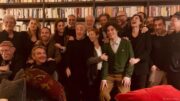A collection of writings with 52 texts by Umberto Eco gathered in the book Sulla televisione. Scritti 1956-2015 edited by Gianfranco Marrone (published by La nave di Teseo).
“For Umberto Eco, television has always been his savage, his field of study. Just as anthropologists and scientists all have their own fields of investigation, this was his field of study, the one he used to build his theory, namely semiotics”, explains Gianfranco Marrone during the presentation of the volume at LUISS Guido Carli University in Rome. In particular, the author wanted to underline the interest of Umberto Eco, collecting the theories developed by the semiotician over the years. One of the peculiarities of the volume is precisely this: to retrace the studies of Eco on TV over a very long period of time, bringing together not only the essays, but also texts of various kinds, such as the famous “Bustine di minerva”, articles from his editorial column published on L’Espresso.
During the event, there were some reflections also about today’s television building a real analysis from the theories of Umberto Eco up to the direct experiences of the experts involved. Guests of the round table together with the author Gianfranco Marrone, Msgr. Dario Edoardo Viganò (Councillor for the Department of Communication, Holy See), Paolo Peverini (Professor Luiss “Guido Carli” and consultant of the Department of Communication), Laura Carafoli (responsible for the contents, Discovery Group) and Isabella Pezzini (Professor La Sapienza, University of Rome).
In Umberto Eco’s studios, a crucial point in the evolution of television is the arrival of live recording. On this point, Msgr. Dario Edoardo Viganò illustrated how the Vatican Media (previously Vatican Television Centre) showed to the world the farewell of Pope Benedict XVI, his greeting to Rome and the world, by helicopter, recalling the initial scene of La dolce vita by Federico Fellini, in which a statue of Christ was taken to St. Peter’s Basilica.
Still in relation to the studies undertaken by Umberto Eco, another distinctive feature of today’s television is its authenticity, as highlighted by Laura Carafoli (SVP Chief Content Officer Discovery Southern Europe at Discovery Communications). In this sense, Discovery channels launched what could be defined as a revolution in Italian television, in which the factual genre became prevalent in its programming. A winning bet, the one for channels like Realtime and DMax, which today in some way inspired other networks, as the emblematic case of the program Il Collegio of Rai2.
In the development of the theories related to television, it is important not to forget, however, that the same medium has undergone a transformation and evolution so that today we talk more and more about smart TV. This change requires not only different contents compared to the past, but above all gives the viewer the opportunity to use television in completely new ways.




